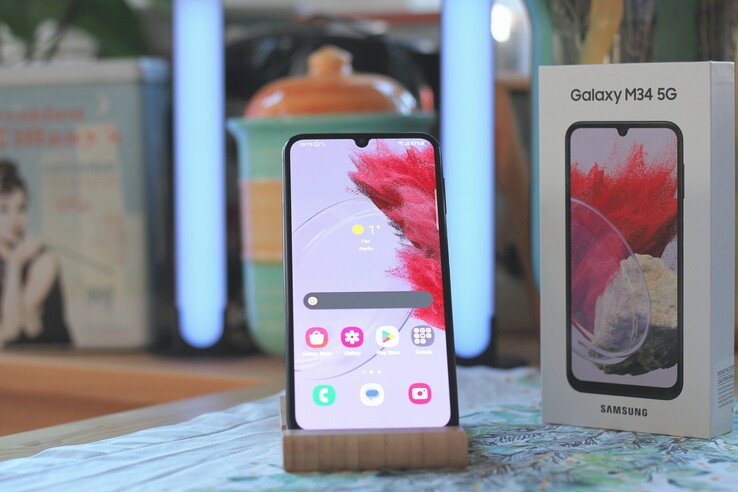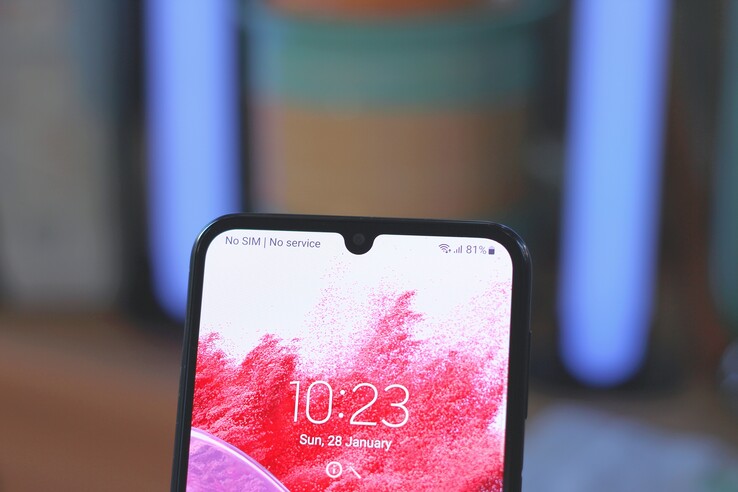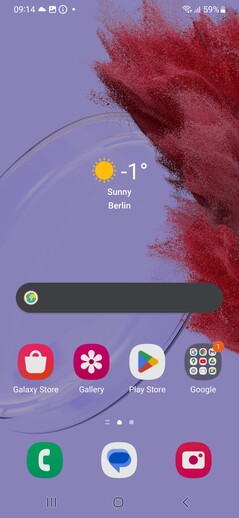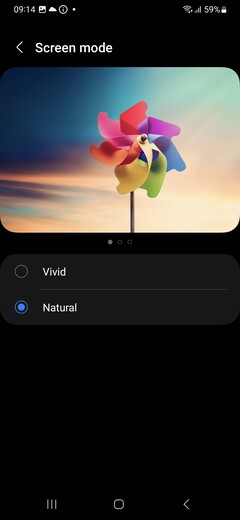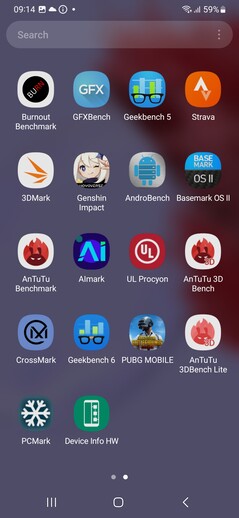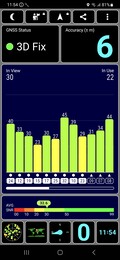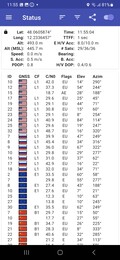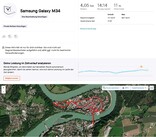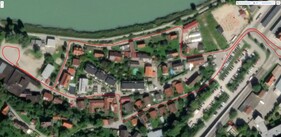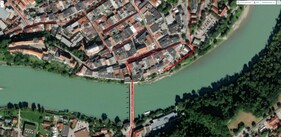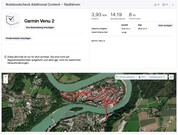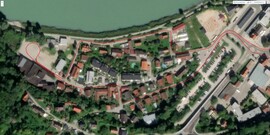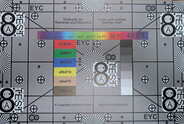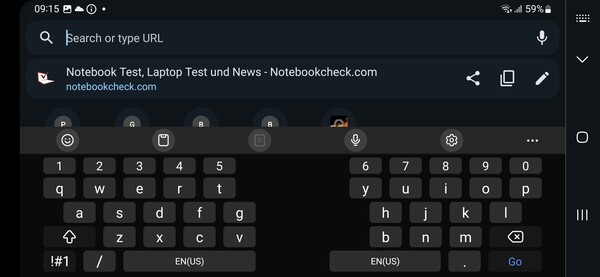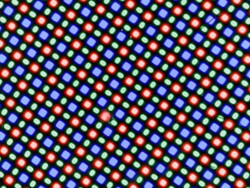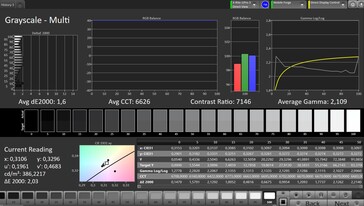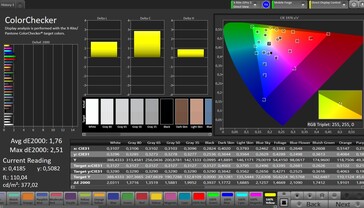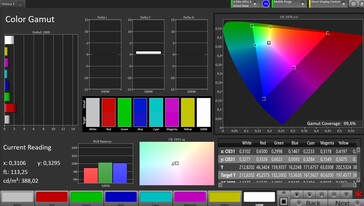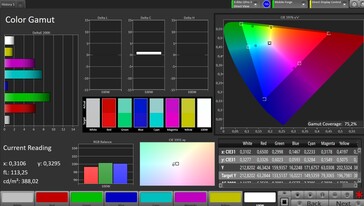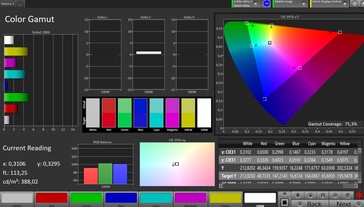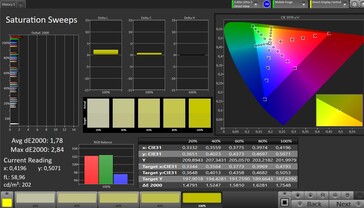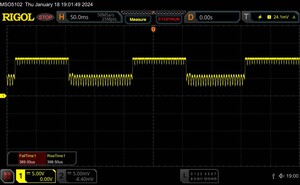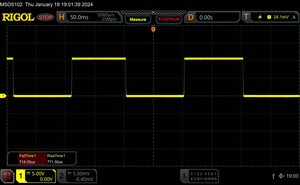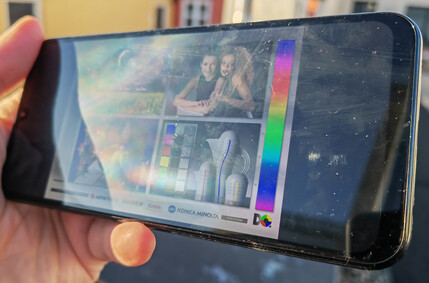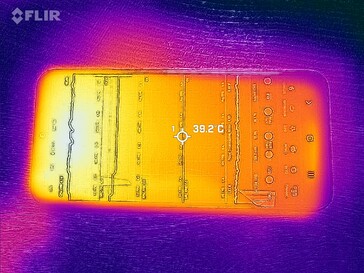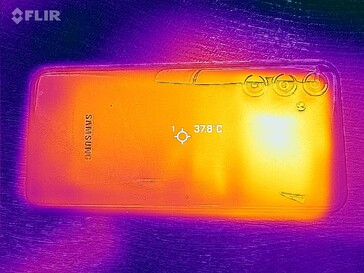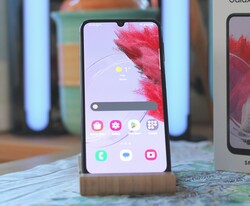Samsung Galaxy M34 5G smartphone review – The king of endurance for US$330
What happened to Samsung's Galaxy-M series in 2023? Not a single new model was released, giving the impression that Samsung forgot about its second mid-range series—next to the Galaxy-A smartphones.
But right at the beginning of 2024, Samsung has gone on the offensive, releasing several new devices. One of these is the Samsung Galaxy M34 5G which, at least visually, differs quite a bit from the 2022 Galaxy M33 5G.
At the same time, the smartphone is cheaper than its predecessor and features a larger battery. We will now be taking a closer look at whether the Samsung Galaxy M34 5G has taken a step forward or backwards, and for whom the phone is worth buying.
Possible competitors compared
Rating | Date | Model | Weight | Drive | Size | Resolution | Price |
|---|---|---|---|---|---|---|---|
| 83.7 % v7 (old) | 02 / 2024 | Samsung Galaxy M34 5G Exynos 1280, Mali-G68 MP4 | 208 g | 128 GB UFS 2.2 Flash | 6.50" | 2340x1080 | |
| 81 % v7 (old) | 07 / 2022 | Samsung Galaxy M33 5G Exynos 1280, Mali-G68 MP4 | 198 g | 128 GB UFS 2.2 Flash | 6.60" | 2408x1080 | |
| 82.2 % v7 (old) | 11 / 2023 | Motorola Moto G84 SD 695 5G, Adreno 619 | 166.8 g | 256 GB UFS 2.2 Flash | 6.50" | 2400x1080 | |
| 78.2 % v7 (old) | 04 / 2023 | Telekom T Phone Pro Dimensity 700, Mali-G57 MP2 | 215 g | 128 GB UFS 2.0 Flash | 6.82" | 1640x720 | |
| 78.5 % v7 (old) | 06 / 2023 | Honor X8a Helio G88, Mali-G52 MP2 | 179 g | 128 GB eMMC Flash | 6.70" | 2388x1080 |
Case – Well-made plastic
While the back of its predecessor featured a matte and shiny design, the Samsung Galaxy M34 5G has a reflective back—which you can get in black, light blue or dark blue. The case is made from plastic. Fingerprints have it easy and even after a few minutes of use, you begin to notice them accumulate. This makes frequent cleaning a must, unless you want to use the phone with a case.
The camera module looks completely different to the Galaxy M33 from 2022. The current device fits very well into Samsung's modernized design language featuring individual lenses. You can also see this in its top-of-the-range model, the Samsung Galaxy S24. Whether you like this will simply come down to personal taste.
Weighing 208 grams, the Galaxy M34 5G is 10 grams heavier than its predecessor and for an affordable mid-range phone, it has a good amount of heft to it. Fans of lightweight smartphones will have to look elsewhere.
The smartphone is built well and it also features great stability: You can barely twist the device and firm pressure doesn't cause any noises. The case is IP67-certified which means you can even take the Galaxy M34 with you on short dives into shallow freshwater without it getting damaged.
Connectivity – Fast storage and a microSD slot
The manufacturer has adopted the phone's 128 GB UFS-2.2 flash storage from its predecessor. This means the phone is about class-average in this aspect. Its 6 GB RAM is enough for everyday use and is also standard within this price range—even though Motorola has shown that you can install more RAM for the same price with its Moto G84.
Our test device features a 3.5-mm audio jack, supports NFC for contactless payments, and masters current Bluetooth 5.3.
There are two nano-SIM-card slots, whereby one can alternatively be used to insert a microSD, letting you expand the phone's storage.
microSD card reader
The device's card reader accepts microSD cards up to 1 TB in size. In our test, it proved to be comparatively speedy using our reference microSD card Angelbird V60, but it couldn't come close to taking advantage of the professional card's possible transfer rates.
When evaluating the CPDT benchmark, we noticed a very similar pattern to its predecessor: Its transfer rates fluctuate greatly in short intervals, but are slightly higher overall than comparable devices.
| SD Card Reader - average JPG Copy Test (av. of 3 runs) | |
| Motorola Moto G84 (Angelbird V60) | |
| Samsung Galaxy M34 5G (Angelbird V60) | |
| Samsung Galaxy M33 5G (Angelbird V60) | |
| Telekom T Phone Pro (Angelbird AV Pro V60) | |
Cross Platform Disk Test (CPDT)
Software – OneUI with few preinstalled apps
Android 13 is the preinstalled operating system with Samsung's in-house OneUI 5.1 interface overlaid. The latest security patch was from 1st September 2023 which, at the time of writing, is over a quarter of a year old—although Samsung promises quarterly updates for this phone according to its website. The manufacturer hasn't given any information on how long this will be the case for the Galaxy-M models. It will supposedly receive one to two bigger Android updates and its predecessor has just received an update to Android 14.
Aside from its own design language and modified settings structure, the system also uses artificial intelligence in order to make suggestions during use. It can, for example, make music suggestions, among other things.
Samsung has mostly avoided installing third-party apps, which leads to a relatively clean system. However, the system does feature a few of Samsung's own apps such as Messages or the Galaxy Store, which both duplicate some of the additionally installed Google apps' functions. These also can't be completely deleted—just hidden.
Communication and GNSS – WiFi 5 and 5G
The Samsung Galaxy M34 supports WiFi 5, but it can't be classed as one of the fastest devices. Especially when it came to sending, it proved to be slow during our test using the Asus ROG Rapture AXE11000 as a reference router—its predecessor already showed similar issues.
All-in-all, WLAN can be used just fine on the device, connections are relatively stable, but other smartphones within this price range offer considerably faster data throughput.
A 5G modem for cellular connection is also installed and it supports all of the most import frequencies. Unfortunately, the Galaxy M34 isn't entirely a world phone, so you should check whether you can surf the web in your desired location prior to travelling.
Interestingly, the mobile reception icon is displayed even if you don't have a SIM card installed into the phone. This seems to be a software error.
The Samsung phone located quite quickly outside, but only with an accuracy of 6 meters. To do so, it uses all the important satellite networks—apart from SBAS which ensures even more accurate locating.
In our practical test, which consisted of a trip around the city (due to the winter weather we did this from the comfort of our car), the Galaxy M34 5G quickly proved to be an excellent navigation device.
It almost always correctly placed us on the street and if anything, it only showed some smaller inaccuracies. The phone even mastered more difficult parts of the trip, such as the turning point or driving over a bridge, with no issues.
Telephone features and call quality – Present conversations
Samsung uses its own telephone app which is constructed slightly differently from the standard Android one. However, you can also easily install and use this one from the Play Store after purchasing the device. Samsung's app works perfectly too and after finding your feet, you can easily find contacts or call numbers.
The phone's call quality is decent. We did note the occasional loss in sound, but it generally appears very present and you can understand the person on the other end of the call well. Our voice was transmitted well too—even if we didn't talk very loud.
You can also make calls via the hands-free microphone and loudspeaker with almost no restrictions, you just have to make sure to speak loud enough. Otherwise, the microphone struggles to transmit your voice.
Cameras – Good picture quality on the Galaxy M34 5G
Samsung has installed a 50-megapixel sensor onto the back of its phone and the two other lenses are a wide-angle camera with an 8-megapixel resolution and a 2-megapixel macro lens.
Photos taken on the main camera appear quite lightened and feature average levels of detail. Compared to high-end cameras, you can see clear deficits when you enlarge its photos: For example, the ice on the plant's leaves can only be recognized very roughly, whereas the iPhone 15 and Honor Magic5 Pro depict them in a lot more detail.
Even in low-light conditions with high contrast, the Galaxy M34 5G's pictures impress with their great brightness—but they often look a bit blurry and the candle flame was overexposed.
Videos can be recorded in 4K at up to 30 fps, in Full HD even at 60 fps. The autofocus usually takes a few moments to adapt to new scenes, while the brightness adjusts quite quickly. The resulting videos look relatively good in total.
If you would like to use the wide-angle lens, then you will be surprised at how sharp the pictures end up being. Even so, smaller details such as the water level indicator on the other bank of the river cannot be seen.
A 13-megapixel front-facing camera, which is housed within a water drop notch, takes care of selfies. It takes well-lit photos which can also be enlarged a little, as enough detail is captured by the camera.
Image comparison
Choose a scene and navigate within the first image. One click changes the position on touchscreens. One click on the zoomed-in image opens the original in a new window. The first image shows the scaled photograph of the test device.
Main camera plantMain camera surroundingsMain camera low lightWide-angle cameraThe main camera also impressed in our test lab with optimal lighting, although some parts of the image appeared somewhat washed out. However, the contrast levels were good overall and the sharpness hardly dropped off towards the edges. In very low light, the image was still roughly recognizable.
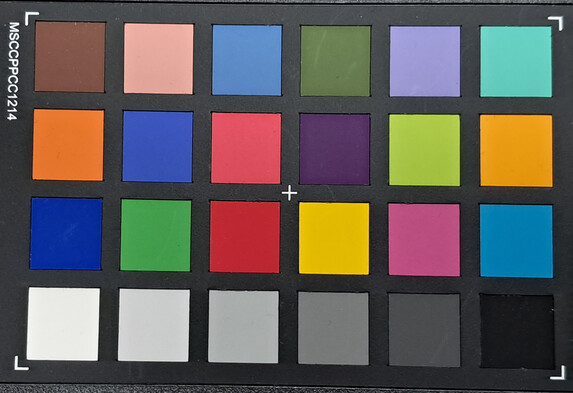
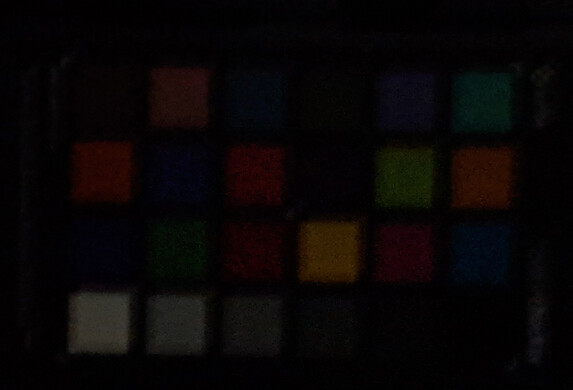
Accessories and warranty – Delivered without a charger
Samsung doesn't deliver the Galaxy M34 5G with a power supply. The manufacturer charges about US$40 for the original charger but a weaker adapter can already be found for US$15. However, then you can't take advantage of the phone's full charging speed. During our test, our phone had no issues using chargers from different manufacturers.
The phone only comes delivered with a USB cable and a SIM tool. Samsung doesn't offer any accessories made specifically for this mid-range model. You can find protective cases from many third-party sellers online.
The Samsung phone is covered by a 24-month warranty. In addition to the dealer warranty, you can also contact the manufacturer's service centres in many larger cities—lots of repairs are even possible at a fixed price.
Input devices & operation – Precise fingerprint sensor
The display keyboard can be operated well and smoothly. If you would rather use a different app, there are plenty of keyboards to choose from in the Play Store that can be downloaded and set as your standard option.
The phone's screen is quite fast thanks to its refresh rate of 120 Hz, meaning it can be operated very promptly and reliably. It's sensitive right into the corners and it even responds to fine touches.
A fingerprint sensor is integrated into the standby button on the right side of the device. The phone takes a few seconds to unlock after new fingerprints have been saved. After this, we placed our finger onto the sensor and the phone was immediately unlocked from standby mode. The smartphone also features facial recognition, although it sometimes takes a moment or two to recognize faces—but it works just as reliably.
Display – Bright 120-Hz AMOLED
The Super AMOLED screen has long been one of the strengths of many mid-range Samsung devices. The Galaxy M34 5G, too, features an OLED display with an extended Full HD resolution. It is 0.1 inches smaller than on its predecessor which only had an IPS screen.
Our current test device's screen is super bright with precise color depiction: It reaches up to 911 cd/m², which is comparable to the best devices within the price class.
Using an oscilloscope, you can see that the display flickers across all brightness levels: While it corresponds to its frame rate of 120 Hz at minimum brightness, it becomes significantly faster above this, measuring 240 Hz. Sensitive people may well experience some issues when using the phone. We would therefore recommend trying it out in-store before purchasing.
| |||||||||||||||||||||||||
Brightness Distribution: 95 %
Center on Battery: 883 cd/m²
Contrast: ∞:1 (Black: 0 cd/m²)
ΔE ColorChecker Calman: 1.76 | ∀{0.5-29.43 Ø4.78}
ΔE Greyscale Calman: 1.6 | ∀{0.09-98 Ø5}
99.6% sRGB (Calman 2D)
Gamma: 2.109
CCT: 6626 K
| Samsung Galaxy M34 5G Super AMOLED, 2340x1080, 6.5" | Samsung Galaxy M33 5G IPS, 2408x1080, 6.6" | Motorola Moto G84 P-OLED, 2400x1080, 6.5" | Telekom T Phone Pro IPS, 1640x720, 6.8" | Honor X8a IPS, 2388x1080, 6.7" | |
|---|---|---|---|---|---|
| Screen | -124% | -11% | -155% | -20% | |
| Brightness middle (cd/m²) | 883 | 545 -38% | 894 1% | 436 -51% | 492 -44% |
| Brightness (cd/m²) | 888 | 530 -40% | 889 0% | 392 -56% | 481 -46% |
| Brightness Distribution (%) | 95 | 92 -3% | 94 -1% | 85 -11% | 94 -1% |
| Black Level * (cd/m²) | 0.5 | 0.28 | 0.38 | ||
| Colorchecker dE 2000 * | 1.76 | 5.02 -185% | 1.1 37% | 5.2 -195% | 1.32 25% |
| Colorchecker dE 2000 max. * | 2.51 | 7.9 -215% | 2.81 -12% | 9.5 -278% | 3.37 -34% |
| Greyscale dE 2000 * | 1.6 | 5.8 -263% | 3 -88% | 7 -338% | 1.9 -19% |
| Gamma | 2.109 104% | 2.399 92% | 2.252 98% | 2.29 96% | 2.194 100% |
| CCT | 6626 98% | 7942 82% | 7122 91% | 8585 76% | 6288 103% |
| Contrast (:1) | 1090 | 1557 | 1295 |
* ... smaller is better
Screen Flickering / PWM (Pulse-Width Modulation)
| Screen flickering / PWM detected | 119.6 Hz | ||
The display backlight flickers at 119.6 Hz (worst case, e.g., utilizing PWM) . The frequency of 119.6 Hz is very low, so the flickering may cause eyestrain and headaches after extended use. In comparison: 53 % of all tested devices do not use PWM to dim the display. If PWM was detected, an average of 8111 (minimum: 5 - maximum: 343500) Hz was measured. | |||
Measurement series with fixed zoom level and different brightness settings
We didn't measure a color tint using our CalMAN software and a spectral photometer. All-in-all, it reproduces gray tones and color very accurately—but you should make sure to select the profile "natural" which desaturates the colors ever so slightly.
The screen's response times are excellent, which should make even the most demanding users happy.
Display Response Times
| ↔ Response Time Black to White | ||
|---|---|---|
| 0.8 ms ... rise ↗ and fall ↘ combined | ↗ 0.4 ms rise | |
| ↘ 0.4 ms fall | ||
| The screen shows very fast response rates in our tests and should be very well suited for fast-paced gaming. In comparison, all tested devices range from 0.1 (minimum) to 240 (maximum) ms. » 2 % of all devices are better. This means that the measured response time is better than the average of all tested devices (20.2 ms). | ||
| ↔ Response Time 50% Grey to 80% Grey | ||
| 1.5 ms ... rise ↗ and fall ↘ combined | ↗ 0.7 ms rise | |
| ↘ 0.8 ms fall | ||
| The screen shows very fast response rates in our tests and should be very well suited for fast-paced gaming. In comparison, all tested devices range from 0.165 (minimum) to 636 (maximum) ms. » 6 % of all devices are better. This means that the measured response time is better than the average of all tested devices (31.6 ms). | ||
Outside, the screen remains legible even in relatively direct sunlight, however, its reflectiveness makes it a little difficult to read from it. In bright surroundings, the phone screen can still be used well.
You can't complain when it comes to the phone's sideway viewing angles, either: The picture remains constant and only loses a tiny bit of contrast.
Performance – With the power of the Exynos
The Samsung Exynos 1280 was already used in its predecessor but within the Samsung Galaxy M34 5G, it is a little faster. This is likely due to driver and software optimizations. In any case, the smartphone offers great performance for its price class and it certainly needn't shy away.
On the other hand, the slightly older processor has not yet been optimized for AI calculations, which became noticeable in the corresponding benchmarks.
| Antutu v9 - Total Score | |
| Average of class Smartphone (99654 - 2056989, n=28, last 2 years) | |
| Samsung Galaxy M34 5G | |
| Motorola Moto G84 | |
| Average Samsung Exynos 1280 (398969 - 434975, n=3) | |
| Telekom T Phone Pro | |
| UL Procyon AI Inference for Android - Overall Score NNAPI | |
| Average of class Smartphone (3769 - 81594, n=139, last 2 years) | |
| Telekom T Phone Pro | |
| Motorola Moto G84 | |
| Samsung Galaxy M34 5G | |
| Average Samsung Exynos 1280 (4126 - 5087, n=5) | |
The Mali-G68 MP4 as a graphics chip secured the Galaxy M34 5G quite a few first places in the graphics benchmarks within the comparison field.
In Full HD, most applications should run smoothly. Only those who wish to view even higher resolutions might run into some problems.
GFXBench (DX / GLBenchmark) 2.7: T-Rex Onscreen | 1920x1080 T-Rex Offscreen
GFXBench 3.0: on screen Manhattan Onscreen OGL | 1920x1080 1080p Manhattan Offscreen
GFXBench 3.1: on screen Manhattan ES 3.1 Onscreen | 1920x1080 Manhattan ES 3.1 Offscreen
GFXBench: on screen Car Chase Onscreen | 1920x1080 Car Chase Offscreen | on screen Aztec Ruins High Tier Onscreen | 2560x1440 Aztec Ruins High Tier Offscreen | on screen Aztec Ruins Normal Tier Onscreen | 1920x1080 Aztec Ruins Normal Tier Offscreen | 3840x2160 4K Aztec Ruins High Tier Offscreen
| 3DMark / Wild Life Extreme Unlimited | |
| Samsung Galaxy M34 5G | |
| Samsung Galaxy M33 5G | |
| Motorola Moto G84 | |
| Telekom T Phone Pro | |
| Honor X8a | |
| 3DMark / Wild Life Extreme | |
| Samsung Galaxy M34 5G | |
| Samsung Galaxy M33 5G | |
| Motorola Moto G84 | |
| Telekom T Phone Pro | |
| Honor X8a | |
| 3DMark / Wild Life Unlimited Score | |
| Samsung Galaxy M34 5G | |
| Samsung Galaxy M33 5G | |
| Motorola Moto G84 | |
| Telekom T Phone Pro | |
| Honor X8a | |
| 3DMark / Wild Life Score | |
| Samsung Galaxy M34 5G | |
| Samsung Galaxy M33 5G | |
| Motorola Moto G84 | |
| Telekom T Phone Pro | |
| Honor X8a | |
| 3DMark / Sling Shot Extreme (Vulkan) Unlimited Physics | |
| Motorola Moto G84 | |
| Telekom T Phone Pro | |
| Samsung Galaxy M34 5G | |
| Samsung Galaxy M33 5G | |
| 3DMark / Sling Shot Extreme (Vulkan) Unlimited Graphics | |
| Samsung Galaxy M34 5G | |
| Samsung Galaxy M33 5G | |
| Motorola Moto G84 | |
| Telekom T Phone Pro | |
| 3DMark / Sling Shot Extreme (Vulkan) Unlimited | |
| Samsung Galaxy M34 5G | |
| Samsung Galaxy M33 5G | |
| Motorola Moto G84 | |
| Telekom T Phone Pro | |
| 3DMark / Sling Shot Extreme (ES 3.1) Unlimited Physics | |
| Telekom T Phone Pro | |
| Motorola Moto G84 | |
| Samsung Galaxy M34 5G | |
| Samsung Galaxy M33 5G | |
| Honor X8a | |
| 3DMark / Sling Shot Extreme (ES 3.1) Unlimited Graphics | |
| Samsung Galaxy M34 5G | |
| Samsung Galaxy M33 5G | |
| Motorola Moto G84 | |
| Telekom T Phone Pro | |
| Honor X8a | |
| 3DMark / Sling Shot Extreme (ES 3.1) Unlimited | |
| Samsung Galaxy M34 5G | |
| Samsung Galaxy M33 5G | |
| Motorola Moto G84 | |
| Telekom T Phone Pro | |
| Honor X8a | |
| GFXBench (DX / GLBenchmark) 2.7 / T-Rex Onscreen | |
| Samsung Galaxy M34 5G | |
| Motorola Moto G84 | |
| Telekom T Phone Pro | |
| Honor X8a | |
| GFXBench (DX / GLBenchmark) 2.7 / T-Rex Offscreen | |
| Samsung Galaxy M34 5G | |
| Motorola Moto G84 | |
| Telekom T Phone Pro | |
| Honor X8a | |
| GFXBench 3.0 / Manhattan Onscreen OGL | |
| Samsung Galaxy M34 5G | |
| Telekom T Phone Pro | |
| Motorola Moto G84 | |
| Honor X8a | |
| GFXBench 3.0 / 1080p Manhattan Offscreen | |
| Samsung Galaxy M34 5G | |
| Motorola Moto G84 | |
| Telekom T Phone Pro | |
| Honor X8a | |
| GFXBench 3.1 / Manhattan ES 3.1 Onscreen | |
| Telekom T Phone Pro | |
| Samsung Galaxy M34 5G | |
| Motorola Moto G84 | |
| Honor X8a | |
| GFXBench 3.1 / Manhattan ES 3.1 Offscreen | |
| Samsung Galaxy M34 5G | |
| Motorola Moto G84 | |
| Telekom T Phone Pro | |
| Honor X8a | |
| GFXBench / Car Chase Onscreen | |
| Telekom T Phone Pro | |
| Samsung Galaxy M34 5G | |
| Motorola Moto G84 | |
| Honor X8a | |
| GFXBench / Car Chase Offscreen | |
| Samsung Galaxy M34 5G | |
| Motorola Moto G84 | |
| Telekom T Phone Pro | |
| Honor X8a | |
| GFXBench / Aztec Ruins High Tier Onscreen | |
| Telekom T Phone Pro | |
| Samsung Galaxy M34 5G | |
| Samsung Galaxy M33 5G | |
| Motorola Moto G84 | |
| Honor X8a | |
| GFXBench / Aztec Ruins High Tier Offscreen | |
| Samsung Galaxy M34 5G | |
| Samsung Galaxy M33 5G | |
| Motorola Moto G84 | |
| Telekom T Phone Pro | |
| Honor X8a | |
| GFXBench / Aztec Ruins Normal Tier Onscreen | |
| Telekom T Phone Pro | |
| Samsung Galaxy M34 5G | |
| Samsung Galaxy M33 5G | |
| Motorola Moto G84 | |
| Honor X8a | |
| GFXBench / Aztec Ruins Normal Tier Offscreen | |
| Samsung Galaxy M34 5G | |
| Samsung Galaxy M33 5G | |
| Motorola Moto G84 | |
| Telekom T Phone Pro | |
| Honor X8a | |
| GFXBench / 4K Aztec Ruins High Tier Offscreen | |
| Samsung Galaxy M34 5G | |
| Samsung Galaxy M33 5G | |
| Motorola Moto G84 | |
| Telekom T Phone Pro | |
| Honor X8a | |
The Galaxy smartphone also performed quite well in our browser tests. In practice, this means that even more complex pages load quite quickly. Although images aren't always available immediately when scrolling, they load quite quickly.
| Jetstream 2 - 2.0 Total Score | |
| Average of class Smartphone (23.8 - 387, n=153, last 2 years) | |
| Motorola Moto G84 (Chrome 118) | |
| Samsung Galaxy M34 5G (Chrome 120) | |
| Average Samsung Exynos 1280 (63.5 - 102.3, n=5) | |
| Telekom T Phone Pro (Chrome 112) | |
| Speedometer 2.0 - Result 2.0 | |
| Average of class Smartphone (15.2 - 643, n=126, last 2 years) | |
| Samsung Galaxy M34 5G (Chrome 120) | |
| Motorola Moto G84 (Chrome 118) | |
| Average Samsung Exynos 1280 (48 - 90.6, n=5) | |
| WebXPRT 4 - Overall | |
| Average of class Smartphone (27 - 306, n=149, last 2 years) | |
| Average Samsung Exynos 1280 (106 - 114, n=3) | |
| Motorola Moto G84 (Chrome 118) | |
| Samsung Galaxy M34 5G (Chrome 120) | |
| Telekom T Phone Pro (Chrome 112) | |
| Octane V2 - Total Score | |
| Average of class Smartphone (2228 - 121337, n=201, last 2 years) | |
| Samsung Galaxy M34 5G (Chrome 120) | |
| Motorola Moto G84 (Chrome 118) | |
| Average Samsung Exynos 1280 (24159 - 32736, n=5) | |
| Telekom T Phone Pro (Chrome 112) | |
| Honor X8a (Chrome 114) | |
| Mozilla Kraken 1.1 - Total | |
| Telekom T Phone Pro (Chrome 112) | |
| Average Samsung Exynos 1280 (1244 - 1920, n=5) | |
| Motorola Moto G84 (Chrome 118) | |
| Samsung Galaxy M34 5G | |
| Average of class Smartphone (257 - 28190, n=156, last 2 years) | |
* ... smaller is better
The Galaxy M34's UFS-2.2 storage performs similarly to most of the test devices when it comes to transfer rates. Only Telekom's T Phone Pro shows that even faster storage is possible.
But in any case, its data transfers are speedy and loading times are kept short.
| Samsung Galaxy M34 5G | Samsung Galaxy M33 5G | Motorola Moto G84 | Telekom T Phone Pro | Honor X8a | Average 128 GB UFS 2.2 Flash | Average of class Smartphone | |
|---|---|---|---|---|---|---|---|
| AndroBench 3-5 | -30% | -4% | 8% | -66% | 10% | 179% | |
| Sequential Read 256KB (MB/s) | 520 | 505.2 -3% | 506.9 -3% | 948 82% | 278.1 -47% | 736 ? 42% | 2226 ? 328% |
| Sequential Write 256KB (MB/s) | 493 | 396.6 -20% | 511.5 4% | 455 -8% | 224.2 -55% | 532 ? 8% | 1848 ? 275% |
| Random Read 4KB (MB/s) | 205.1 | 89.3 -56% | 195.8 -5% | 141 -31% | 61.6 -70% | 193 ? -6% | 295 ? 44% |
| Random Write 4KB (MB/s) | 197.4 | 113.8 -42% | 174.7 -11% | 173 -12% | 18.7 -91% | 186.3 ? -6% | 335 ? 70% |
Games – Gaming at 60 fps only possible sometimes
You can play games quite well on the Galaxy M34 5G, but you can only expect 60 fps when running very simple ones: PUBG Mobile doesn't even offer any frame rates above 30 and in Genshin Impact, you only have a chance to hit 60 fps every now and then with the details kept to a minimum. Even so, these high frame rates can never be kept for long.
Genshin Impact doesn't run very smoothly with very high details—even though the frame rates balance out at 30 fps after a while, we still noted visible micro-stutters. We tested the smartphone's gaming performance using software from GameBench.
Controlling games via the phone's touchscreen and position sensor works very reliably.
Emissions – No throttling during use
Temperature
We measured temperatures up to 43.8 °C after subjecting the smartphone to a longer stress test. In everyday use, the phone should rarely hit these temperatures and even if it does, they aren't really critical.
Furthermore, the phone isn't throttled under longer periods of load, as the 3DMark stress test showed.
(±) The maximum temperature on the upper side is 43.8 °C / 111 F, compared to the average of 35.2 °C / 95 F, ranging from 21.9 to 247 °C for the class Smartphone.
(±) The bottom heats up to a maximum of 43.1 °C / 110 F, compared to the average of 34 °C / 93 F
(+) In idle usage, the average temperature for the upper side is 25.6 °C / 78 F, compared to the device average of 32.9 °C / 91 F.
3DMark Wild Life Stress Test
| 3DMark | |
| Wild Life Stress Test Stability | |
| Motorola Moto G84 | |
| Samsung Galaxy M34 5G | |
| Telekom T Phone Pro | |
| Honor X8a | |
| Wild Life Extreme Stress Test | |
| Telekom T Phone Pro | |
| Motorola Moto G84 | |
| Samsung Galaxy M34 5G | |
| Honor X8a | |
Speakers
The small speaker along the bottom of the device has to make do by itself, meaning the Galaxy M34 only features mono sound. It does sound comparatively powerful, as Samsung emphasizes the low mids. In addition, the speaker reaches a good maximum volume, allowing you to fill a medium-sized room with sound.
Real sound enthusiasts will still prefer to use headphones—these can be connected via the 3.5-mm jack or Bluetooth. Samsung only supports the most important wireless codecs and the only one that is reasonably suitable for Hi-Res is its own SSC, which not all headsets support.
Samsung Galaxy M34 5G audio analysis
(+) | speakers can play relatively loud (83.8 dB)
Bass 100 - 315 Hz
(-) | nearly no bass - on average 27.1% lower than median
(±) | linearity of bass is average (11.8% delta to prev. frequency)
Mids 400 - 2000 Hz
(+) | balanced mids - only 4.8% away from median
(+) | mids are linear (5.6% delta to prev. frequency)
Highs 2 - 16 kHz
(±) | higher highs - on average 5.7% higher than median
(±) | linearity of highs is average (7% delta to prev. frequency)
Overall 100 - 16.000 Hz
(±) | linearity of overall sound is average (20.6% difference to median)
Compared to same class
» 35% of all tested devices in this class were better, 9% similar, 56% worse
» The best had a delta of 11%, average was 35%, worst was 134%
Compared to all devices tested
» 54% of all tested devices were better, 8% similar, 38% worse
» The best had a delta of 4%, average was 24%, worst was 134%
Honor X8a audio analysis
(±) | speaker loudness is average but good (80.3 dB)
Bass 100 - 315 Hz
(-) | nearly no bass - on average 29.1% lower than median
(±) | linearity of bass is average (8.4% delta to prev. frequency)
Mids 400 - 2000 Hz
(±) | higher mids - on average 6.6% higher than median
(±) | linearity of mids is average (9.4% delta to prev. frequency)
Highs 2 - 16 kHz
(+) | balanced highs - only 4.5% away from median
(±) | linearity of highs is average (10.7% delta to prev. frequency)
Overall 100 - 16.000 Hz
(±) | linearity of overall sound is average (26.3% difference to median)
Compared to same class
» 66% of all tested devices in this class were better, 6% similar, 28% worse
» The best had a delta of 11%, average was 35%, worst was 134%
Compared to all devices tested
» 80% of all tested devices were better, 4% similar, 16% worse
» The best had a delta of 4%, average was 24%, worst was 134%
Battery life – Quite impressive
Power consumption
The Samsung Galaxy M34 5G doesn't handle its power very frugally; it uses considerably more than the comparison devices under load, in particular.
You can use a maximum of 25 watts to charge the phone back up again. As the battery doesn't exactly have little capacity, it can take 3 hours or longer until the device is charged fully.
| Off / Standby | |
| Idle | |
| Load |
|
Key:
min: | |
| Samsung Galaxy M34 5G 6000 mAh | Motorola Moto G84 5000 mAh | Telekom T Phone Pro 5000 mAh | Average Samsung Exynos 1280 | Average of class Smartphone | |
|---|---|---|---|---|---|
| Power Consumption | 14% | 1% | -1% | -18% | |
| Idle Minimum * (Watt) | 1 | 1 -0% | 0.61 39% | 0.996 ? -0% | 0.848 ? 15% |
| Idle Average * (Watt) | 1.2 | 1.3 -8% | 2.05 -71% | 1.374 ? -15% | 1.434 ? -20% |
| Idle Maximum * (Watt) | 1.7 | 1.4 18% | 2.15 -26% | 1.664 ? 2% | 1.618 ? 5% |
| Load Average * (Watt) | 4.5 | 3.5 22% | 3.34 26% | 4.54 ? -1% | 7.01 ? -56% |
| Load Maximum * (Watt) | 8.4 | 5 40% | 5.4 36% | 7.78 ? 7% | 11.3 ? -35% |
* ... smaller is better
Power consumption: Geekbench (150 cd/m²)
Power consumption: GFXBench (150 cd/m²)
Runtimes
According to the manufacturer, the battery has a 6,000-mAh capacity, which is a lot more than the comparison devices.
And in practice, the Samsung Galaxy M34 5G achieves good runtimes that are much better than its predecessor: You can surf the web for 17:44 hours or watch pre-downloaded films for 20 hours. So, if you are looking to watch the cinematic release of the Lord of the Rings trilogy, then you can expect to do so twice before the battery runs out.
Its values aren't as good under load, which shows that the smartphone is quite power-hungry during demanding applications.
| Samsung Galaxy M34 5G 6000 mAh | Samsung Galaxy M33 5G 5000 mAh | Motorola Moto G84 5000 mAh | Telekom T Phone Pro 5000 mAh | Honor X8a 4500 mAh | |
|---|---|---|---|---|---|
| Battery runtime | -19% | -11% | -20% | -12% | |
| Reader / Idle (h) | 35.9 | 33.3 -7% | |||
| H.264 (h) | 20.1 | 16.7 -17% | |||
| WiFi v1.3 (h) | 17.7 | 14.3 -19% | 15.1 -15% | 14.2 -20% | 15.5 -12% |
| Load (h) | 4.8 | 4.6 -4% |
Pros
Cons
Verdict – Happy to be reunited
Samsung's Galaxy-M series is back and it seems that it has used its break to create an improved mid-range smartphone for under US$350—the Samsung Galaxy M34 5G.
Its case features a completely new design and although it won't win any innovation prizes, it is certainly suitable for office use thanks to its discreet appearance. You should just think about purchasing a protective case for the phone so you don't get plagued by constant fingerprint marks which collect on the back. An IP certification keeps the phone safe during voluntary (or accidental) dips into the water.
Its storage capacity is sufficient and if required, you can expand it with the help of a microSD card. The software benefits from not having too much bloatware installed. The Galaxy-M smartphones haven't been given a real update promise, but you can safely expect to at least see Android 14 and—if you take a look at the predecessor models—there will probably be a good few years of security updates.
The phone's location services are very accurate, its cameras take decent photos for the price range and its bright AMOLED screen with accurate color depiction sure is nice to look at. However, only if you don't react sensitively to PWM flickering. Its performance is good and its runtimes are impressive.
It's a little annoying that the device doesn't come delivered with a power supply and if Samsung managed to keep its high consumption rates under load in check, then the phone could manage even longer in between charges.
The Samsung Galaxy M34 5G is back in full swing as a mid-range series, offering a lower price, good connectivity and lots of stamina and in turn, making us happy to be reunited.
The Motorola Moto G84 is slimmer and more attractive—you can even get the phone in bright pink, if you want. The Telekom T Phone Pro can be charged wirelessly and also brings good runtimes to the table, however, at the cost of a dimmer display.
Price and availability
At the time of writing, the Samsung Galaxy M34 5G is not yet available to purchase in the United States.
Samsung Galaxy M34 5G
- 01/30/2024 v7 (old)
Florian Schmitt
Transparency
The selection of devices to be reviewed is made by our editorial team. The test sample was provided to the author as a loan by the manufacturer or retailer for the purpose of this review. The lender had no influence on this review, nor did the manufacturer receive a copy of this review before publication. There was no obligation to publish this review. As an independent media company, Notebookcheck is not subjected to the authority of manufacturers, retailers or publishers.
This is how Notebookcheck is testing
Every year, Notebookcheck independently reviews hundreds of laptops and smartphones using standardized procedures to ensure that all results are comparable. We have continuously developed our test methods for around 20 years and set industry standards in the process. In our test labs, high-quality measuring equipment is utilized by experienced technicians and editors. These tests involve a multi-stage validation process. Our complex rating system is based on hundreds of well-founded measurements and benchmarks, which maintains objectivity. Further information on our test methods can be found here.




